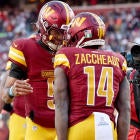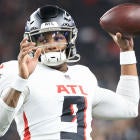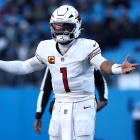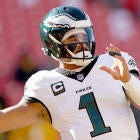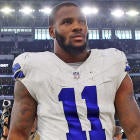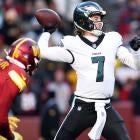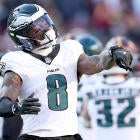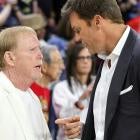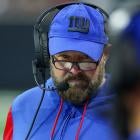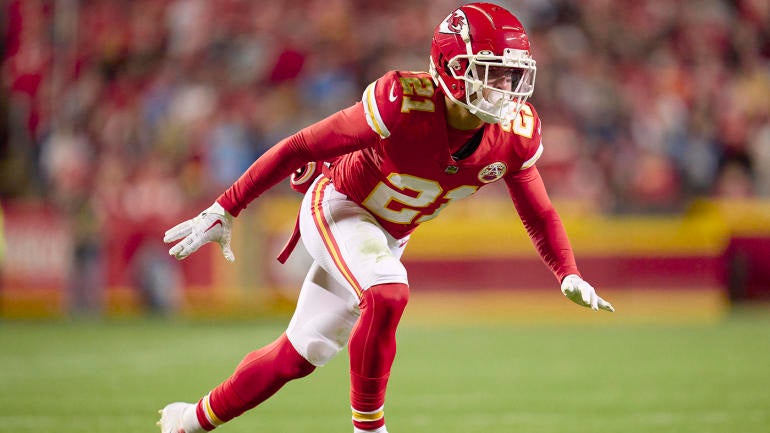
Super Bowl LVII is just a day away. We've been talking for the past week-plus about all the key figures in the game, from Patrick Mahomes and Jalen Hurts to Chris Jones and Lane Johnson and more. But it isn't always the biggest stars who make the deciding plays. Sometimes, it's the role players who have to come up big.
We're here to identify the less-talked-about players on each team who have a chance to make a big impact, mostly due to the ways the opposing team is likely to attack them. These are our X-factors for the Eagles and Chiefs.
Eagles' linebackers and safeties
All season, the Kansas City passing game flowed through star tight end Travis Kelce, who was targeted 152 times during the regular season -- 51 more than the next-closest player on the team (JuJu Smith-Schuster). With the recent injury issues to the Chiefs' wide receivers, Kelce has been even more of a focal point during the playoffs: He's been the targeted receiver on 25 of the team's 80 pass attempts during the playoffs, good for a 31.3% target share. That's up from 23.4% during the regular season.
Kelce and Patrick Mahomes have unmatched chemistry, and they are able to threaten every area of the field. Still, most of their work is done in the short and intermediate areas, and especially over the middle.

That makes Eagles linebackers T.J. Edwards and Kyzir White -- as well as safeties Chauncey Gardner-Johnson, Marcus Epps and Reed Blankenship -- arguably the most important defenders on the team for Sunday's game. That's the group that will most often have the responsibility of covering Kelce, whether the Eagles are playing man or zone.
Philadelphia acquitted itself well against tight ends this season, ranking sixth in Football Outsiders' DVOA on throws to players at the position. Of course, Kelce is not your standard tight end. During the regular season, the following tight ends ran at least 20 routes in a game against the Eagles: T.J. Hockenson, Johnny Mundt, Irv Smith Jr., Logan Thomas, Evan Engram, Zach Ertz, Peyton Hendershot, Pat Freiermuth, Brevin Jordan, Austin Hooper, Chigoziem Okonkwo, Daniel Bellinger, Cole Kmet, Dalton Schultz, Juwan Johnson, Nick Vannett and Lawrence Cager. (In the playoffs, they saw Bellinger again and then George Kittle, but the Niners literally did not have a quarterback capable of throwing the ball for most of the game.) Needless to say, there is not a player remotely in Kelce's league among that group. This is going to be a different type of challenge.
In particular, White has shown that you can take advantage of him when he's in coverage -- especially when he has to slide out to the slot and play in more space. Widening him out and running routes that circle in behind him and in front of the safeties has proven a successful strategy, and the Chiefs should be expected to employ it until he proves he can stop it. (Kelce was targeted on more than 25% of his routes when lined up in the slot, according to Tru Media, catching 53-of-69 passes for 657 yards and three touchdowns on those plays.) The way Mahomes and Kelce are able to work together to find soft spots in zone coverage makes his and Edwards' ability to tackle Kelce immediately and not let him gain yards after the catch incredibly important as well.
The safeties will also have to be on high alert for the freelance, out-of-structure playmaking Mahomes and Kelce get into when Mahomes breaks contain in the pocket. They've created a bunch of big plays in those situations, with Kelce either working back toward Mahomes or up the field and into open space. Keeping a roof on the defense and not allowing Kelce to get in behind them, and thus forcing the Chiefs to methodically work their way down the field, is Philly's best option.
Chiefs' rookie defensive backs
Against the Bengals in the AFC title game, this group showed out. Going up against one of the best wide receiver duos in the NFL (Ja'Marr Chase and Tee Higgins), the quartet of Trent McDuffie, Jaylen Watson, Joshua Williams and Bryan Cook had one of their best collective games of the season. They accounted for all four pass breakups and both interceptions the Chiefs recorded against Joe Burrow, and helped hold the Bengals to just 7.5 yards per attempt overall.
Things will not get much easier for this group in the Super Bowl. If there is a pass-catching duo in the NFL that rivals Chase and Higgins, then A.J. Brown and DeVonta Smith are certainly up there on the list of contenders. They present a multitude of challenges, with Brown's physicality and ability to win the ball in the air and Smith's deep speed and body control testing opposing secondaries in different ways.
It will be interesting to see how the Chiefs choose to line up their corners here, because they have been willing to move McDuffie around quite a bit. During the latter portion of the regular season, he played most often in the slot. In the divisional round, he moved back outside as L'Jarius Sneed slid into the slot to cover Christian Kirk. In the conference championship, McDuffie was back inside. After Sneed left with a concussion, Williams slid into the No. 2 spot on the perimeter opposite Watson. The Chiefs would likely prefer to have Sneed on one of Brown or Smith rather than covering Quez Watkins or Zach Pascal, but Philly moves its receivers around often enough that it'll be difficult to ensure that matchup on every snap.
Either way, the Eagles are surely going to take their shots on the outside when they see that they have one-on-one coverage. Whether the rookies can hold up in those situations how many explosive plays Philly can generate through the passing game. Cook has a role in that as well, even as the team's third safety. His deflection of a Burrow deep ball in the AFC title game caused an interception, and if he can get over the top of a Hurts deep ball and turn a one-on-one into a one-on-two, it reduces the chances of that ball being completed.









